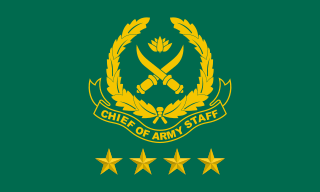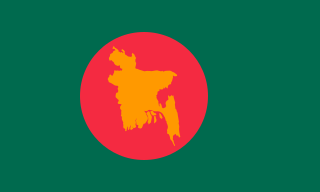
The East Bengal Regiment is an infantry regiment of the Bangladesh Army. It was founded by Major Abdul Gani.
Abu Taher was a Bengali military serviceman, who served in the Pakistan Army, and later in BDF. He crossed into India around early August and reported to the Indian authorities. After a week screening at Dehradun, India, Taher reported to Kolkata, Bangladesh Provincial government at 8 Theatre Rd. He was ordered to report to Sector 11 of Mukti Bahini under command of Major Ziaur Rahman, he became the sector commander after him. He served in BDF from end of August to 2 November 1971. He was awarded the medal Bir Uttom for his gallantry in the liberation war. He was released from military service by Indian military medical board in Pune, India after his leg was amputated. After independence, he was inducted into the Bangladesh Army for administrative retirement with legacy rank of lieutenant colonel. After settling in with family, the government of Bangladesh appointed him with employment at Kumilla. Later Taher turned into a political activist and leader of the left-wing Jatiyo Samajtantrik Dal.

The Bangladesh Army is the land warfare branch and the largest component of the Bangladesh Armed Forces. The primary mission of the Army is to provide necessary forces and capabilities to deliver the Bangladeshi government's security and defence strategies and defending the nation's territorial integrity against external attack. Control of personnel and operations is administered by the Army Headquarters, Dhaka. The Bangladesh Army is also constitutionally obligated to assist the government and its civilian agencies during times of domestic national emergency. This additional role is commonly referred to as "aid to civil administration".
Muhammad Ataul Gani Osmani, was a Bengali military leader. Osmani's career spanned five decades, beginning with service in the British Indian Army in 1939. He fought in the Burma Campaign during World War II. After the partition of India in 1947, he joined the Pakistan Army and served in the East Bengal Regiment, retiring as a colonel in 1967. Osmani joined the Provisional Government of Bangladesh in 1971 as the commander-in-chief of the nascent Bangladesh Forces. Regarded as the founder of the Bangladesh Armed Forces, Osmani retired as a four-star general from the Bangladesh Army in 1972.
Khaled Mosharraf, Bir Uttom was a Bangladeshi army officer who is known for his role in the Bangladesh Liberation War and the subsequent coups in post-independence Bangladesh. After deposing Khondakar Mustaq Ahmad in the 3 November 1975 coup, Mosharraf was assassinated on 7 November 1975.

Armed Forces Day is observed in Bangladesh on 21 November. This signifies the day in 1971, when the members of the Bangladesh army, navy and air force were officially united and launched joint operations against the Pakistan occupation forces. On 16 December 1971, the Pakistani Army of 93,000 surrendered to the allied force of Bangladesh army, ending the Liberation War of Bangladesh.

Chief of Army Staff (CAS) of Bangladesh Army, also known as Army Chief, is the highest-ranking officer of the Bangladesh Army. The Chief of Army staff has been a four-star rank since 2007. Maj. Gen. M. A. Rab was the Chief of Staff Army under the combined command of Bangladesh Forces which served as the origins of Bangladesh Armed Forces. After the War of Independence Bangladesh Army was officially reverted to the Ministry of Defense in 1972 and Maj. Gen. K. M. Shafiullah was appointed the Chief of Army Staff. The current Chief of Army Staff is Gen SM Shafiuddin Ahmed
Shafaat Jamil, Bir Bikrom was a Bangladesh Army colonel. He was the commanding officer of the 3rd East Bengal Regiment of Z Force Brigade in Sector 11 of Bangladesh Forces during the War of Bangladesh Independence in 1971. He was among the first Bengali officers who rebelled against the Pakistani Army in the 1971 Liberation War of Bangladesh and later fought in 11 sector and in Sylhet sector.

1st East Bengal Regiment or 1st Bengal also known by its nickname The Senior Tigers of Bangladesh Army.
The Indian Army had no standby force ready in 1971 with the specific task of attacking East Pakistan, one of the many reasons why India did not immediately intervene after Pakistan launched Operation Searchlight in March 1971. Indian Army's Eastern Command was tasked with defending the northern and eastern borders and fighting the insurgencies in Nagaland, Mizoram and Naxalites in West Bengal at that time.
The Battles of Kamalpur, launched against the Pakistan Army, is one of the most significant battles fought by Bangladeshi Forces in 1971 during its war of independence from Pakistan. The Pakistan Army set up a military camp at Kamalpur which was attacked by 1st East Bengal Regiment of Z Force several times. The first attack was made on June 12, and a second attack was made on July 31, 1971, also another attack at 22 October 1971, India joined the war at Late November, and took their Battalions and Brigade to take Kamalpur, but it was harder for the Indian Army than Expected, They made more than 3 Unsuccessful Attempts to take Kamalpur, their moral was deteriorating, and Casualties were getting higher and higher, but they knew the Pakistan Army and Paramilitaries there had no artillery, only 2 mortars left, Finally, on December 4, the Pakistan Army was overrun had to withdraw and fell back to their headquarters at Jamalpur after an attack by the Bangladesh Forces and Indian Army. In the aftermath of the battle, Pakistani troops were defeated and Jamalpur became free.

The Provisional Government of Bangladesh, popularly known as the Mujibnagar Government; also known as the Bangladeshi government-in-exile, was a provisional government that was established following the declaration of independence of East Pakistan as Bangladesh on 10 April 1971. Headed by prime minister Tajuddin Ahmad, it was the supreme leadership of the Bangladeshi liberation movement, comprising a cabinet, a diplomatic corps, an assembly, an armed force, and a radio service. It operated as a government-in-exile from Kolkata.

Chitta Ranjan Dutta Bir Uttom, also known as C R Dutta, was a Bangladeshi war hero who served as major-general of the Bangladesh Army. He was a key sector commander of the Mukti Bahini during the Bangladesh Liberation War. After independence, he served as the armed forces commander in Rangpur and later went on to become the first director-general of the Bangladesh Rifles in 1973.
Z Force, also known as Tura Brigade, was the first military brigade of Bangladesh Forces formed during the Liberation War of Bangladesh in 1971 under Major Ziaur Rahman along with the consent of the revolutionary government of Bangladesh in exile. The brigade was formed with the 1st, 3rd and 8th Battalion of East Bengal Regiment on 7 July 1971. It is the first ever complete brigade formed during the Liberation War of Bangladesh in 1971.
Bir Bikrom Hafizuddin Ahmed is a Bangladesh Nationalist Party politician, a retired Bangladesh Army major, and a six-term Jatiya Sangsad member representing the Bhola-3 constituency. He fought in the Bangladesh Liberation War and was awarded the third highest gallantry award in Bangladesh, Bir Bikrom, for his courage. He is also a retired footballer and one of the few from East Pakistan to have represented the Pakistan national football team.
K Force was a military brigade of Bangladesh Forces in 1971 headed by Major Khaled Mosharraf as per the direction of the Provisional Government of Bangladesh in exile. The brigade was a part of regular army under the Bangladesh Armed Forces formed with the 4th, 9th and 10th Battalion of East Bengal Regiment.
S Force was a military brigade of the Bangladesh Armed Forces that was formed under the leadership of Major K M Shafiullah on October 1, 1971. The brigade was composed of the 2nd and 11th East Bengal Regiments.

Abu Taher Mohammad Haider, Bir Uttom was a Bangladesh Army officer and recipient of Bir Uttom, the second highest military award in Bangladesh. He fought in the Bangladesh Liberation War as the second-in-command of the K force under Khaled Mosharraf. Later he became the sector commander of sector-2 from September 22, 1971. After the assassination of the President of Bangladesh, Sheikh Mujib in a military coup; he joined a counter coup led by his former commander Major General Khaled Mosharraf. He was killed in a situation marred with confusion along with Khaled Mosharraf on 7 November 1975 by proponents of a counter coup led by Colonel Abu Taher.
Mohammad Ziauddin, BUT is a retired Bangladeshi military officer, who was the Commanding Officer of the 1st East Bengal Regiment during the Bangladesh Liberation War. He was awarded the Bir Uttom, the country's second highest gallantry award for his outstanding bravery in the Liberation War. His certificate number was 22.
Golam Helal Morshed Khan is a retired Major General of the Bangladesh Army and veteran of the Bangladesh Liberation War. He was awarded Bir Bikrom, third highest gallantry award, for his actions in the war. He participated in the 1996 Bangladeshi coup d'état attempt.








